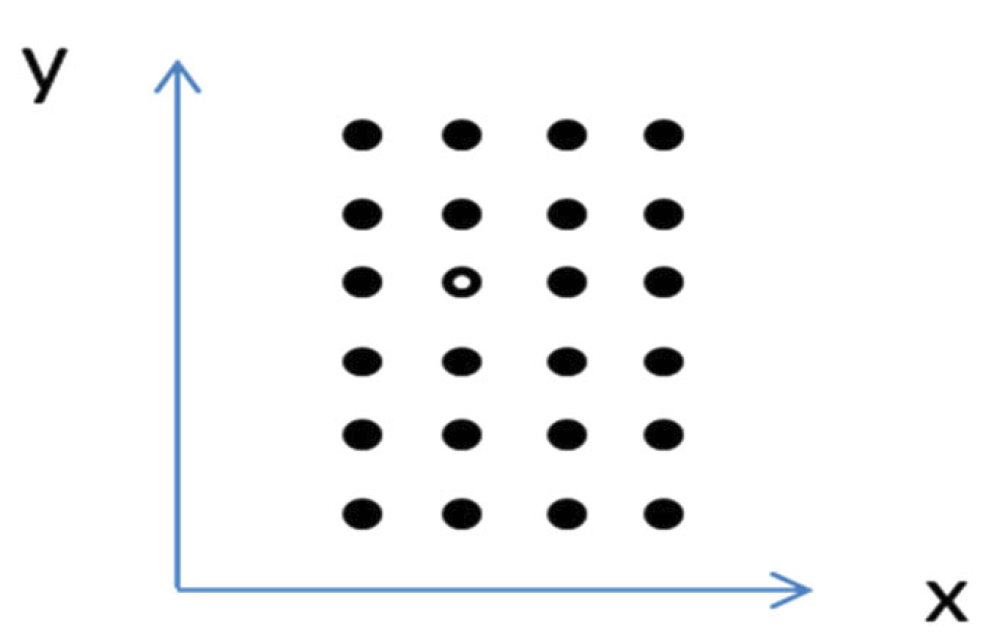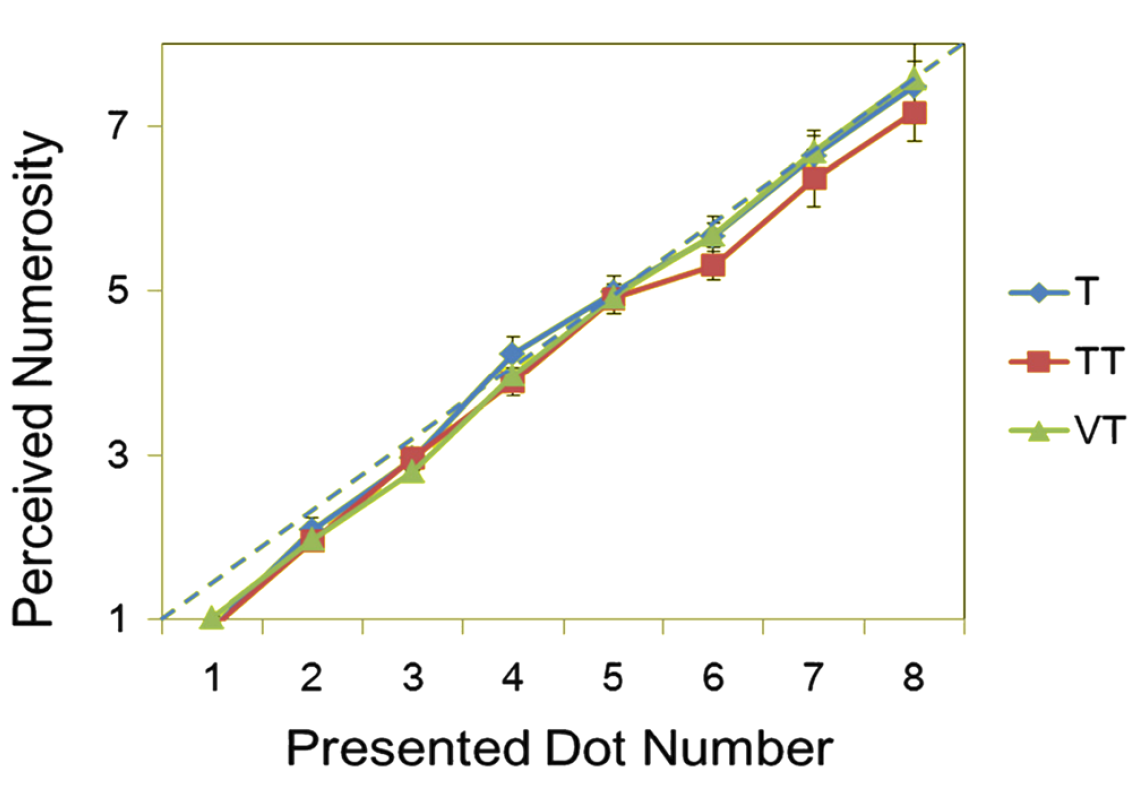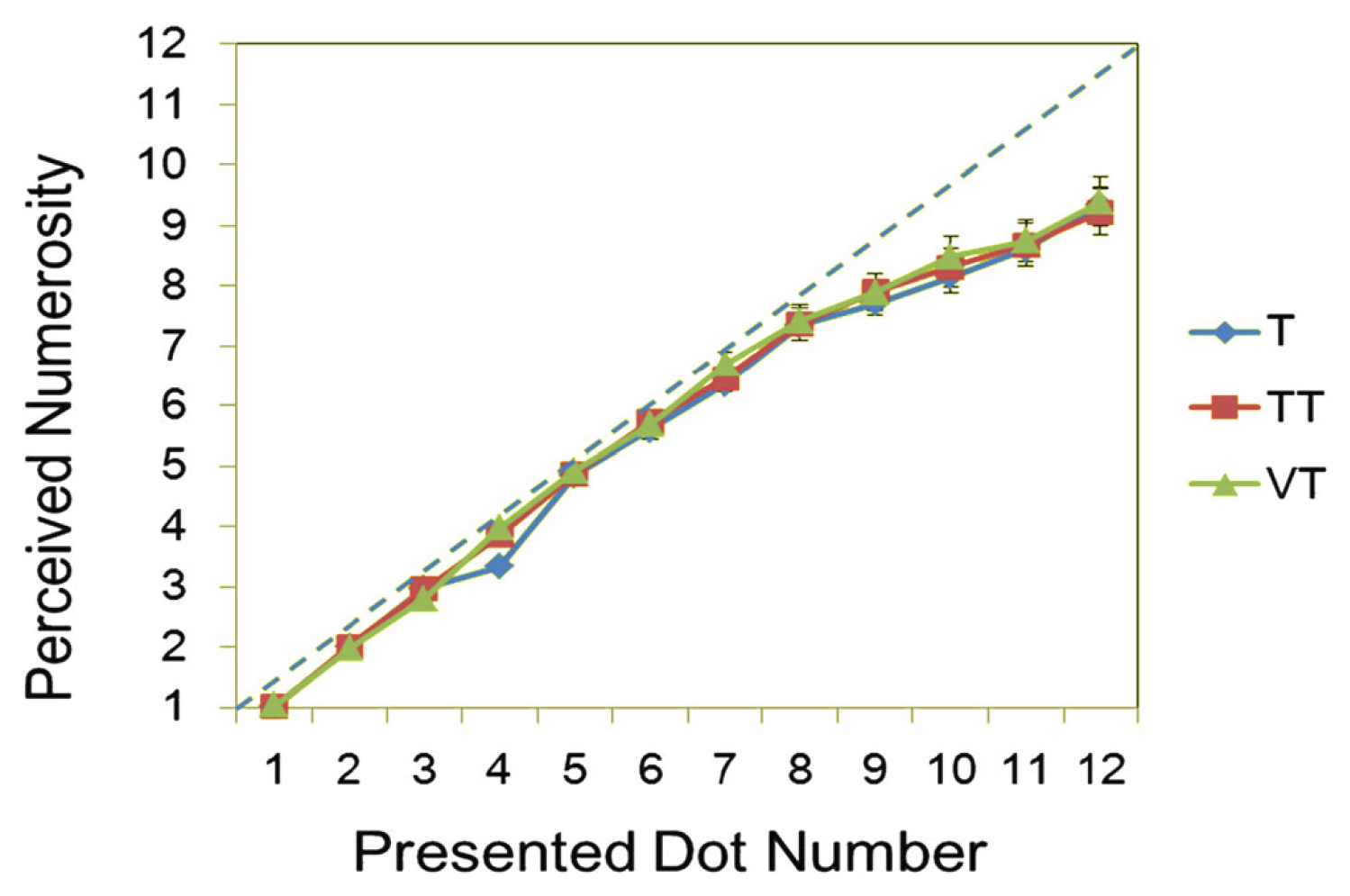Put Tom Cruise and Dustin Hoffman together and you get Rain Man, the Academy-Award winning story of an autistic savant—played by Hoffman who received the Best Actor award for his performance—who turns out to have many unexpected talents. The clip below shows one famous scene, in which Hoffman knows within seconds that the waitress dropped precisely 246 toothpicks on the floor:
All humans are sensitive to numerosity—in fact, we are more sensitive to the number of objects we perceive than we are to other cues such as density or area. And, like Dustin Hoffman, we all have the ability to grasp numerosity in an instant and seemingly without explicitly counting the number of objects. This process is known as “subitizing”.
However, unlike the savant played by Hoffman, most of us can subitize at most 4 objects—any more than that, and we need to either count (time permitting) or estimate the numerosity by some other process.
Although there is widespread agreement that the cognitive processes involved in subitizing differ from those involved in numerosity estimation, the exact nature of those two sets of processes is far from clear.
A recent article in the Psychonomic Society’s journal Attention, Perception, & Psychophysics explored subitizing further by tracking the attentional processes across modalities. Researchers Yue Tian and Lihan Chen used tactile Braille displays and asked participants to estimate the number of raised pins in a pad placed under their finger. The figure below shows the layout of the apparatus:

Anywhere between 1 and 12 pins (the number varied between experiments) could be raised on a single trial; the figure illustrates a trial in which a single pin (indicated by the circle) would be raised. The participants’ primary task was to report the number of raised pins they could detect under their fingertips.
Between trials, modality and attentional demands were varied as shown in the next figure. Consider first the top-left condition, labeled “T”. On those trials, participants simply reported the number of pins they could sense under their right fingertip. In the first experiment, they used a keyboard to report the data whereas in the second study they reported the perceived number verbally.
The remaining two conditions, “TT” and “VT”, required participants to divide their attention between two tasks: numerosity estimation and an “up-down” judgment that involved a decision about whether the top or bottom part of the left stimulus array contained more stimuli.

The two divided-attention conditions differed further by the modality in which the up-down task was presented. In the “TT” condition, the up-down task also involved tactile stimuli, presented below the left index finger. In the “VT” condition, the up-down stimuli were visual, and also required a binary response depending on whether the top or bottom of the display contained more dots. In the figure above, it was the bottom half that contained more dots or pins (3 vs. 2).
The three conditions permitted examination of the effects of divided attention on numerosity judgments, and additionally allowed identification of the role of modality. If performance on the primary task (reporting the number of pins under the right index finger) suffered in the “VT” and “TT” tasks, then this would suggest that the attentional demand of the up-down task interfered with numerosity perception. Further, if those differences in turn varied between those two conditions, this would isolate domain-specific vs. domain-general effects.
The figure below provides a snapshot of the results from the first experiment in which the maximum number of stimuli was 8.

Several comments can be made about the results. First, people’s tactile numerosity judgments were remarkably well calibrated because their reported estimate of the number of dots (or pins) was close to the actual number. Perfect performance would have followed the dashed diagonal line, and it is clear that participants came pretty close to that ideal.
Second, although there is a hint of interference within the same modality in the dual-task condition (compare “TT” to the other two conditions), this difference was not statistically significant. (When the magnitude of errors was considered there was some evidence for dual-task interference for small numbers of dots.)
Finally, and perhaps most intriguingly, there was not much indication of a boundary between subitizing (expected to occur for around 4 or fewer dots) and numerosity estimation (above 4). Based on a large body of previous work, the boundary between subitizing and estimation would have expressed itself as a distinct change in slope of the calibration function.
Tian and Chen therefore conducted another experiment in which up to 12 dots (pins) were presented under the same three attentional conditions. The results are shown in the next figure:

The distinct change in slope of the calibration curve at around 7 or 8 items is the signature effect for the transition from subitizing to numeric estimation.
Once again, there did not appear to be an obvious effect of attentional condition. However, when Tian and Chen explored the data further, the suggestive finding emerged that the second task affected subitizing of small numbers of dots more than it affected numerosity judgments involving larger sets of objects. The full details of these analyses are quite subtle, but to illustrate with one interesting result, Tian and Chen found that there was a correlation between participants’ visual working memory capacity (which was measured in the second experiment using a separate task) and the difference in the magnitude of errors between the “VT” and “TT” conditions—suggesting that the extent of cross-modal interference was modulated by a person’s visual working memory capacity. The fact that this correlation was particularly pronounced for small numbers was one of the indications of a selective effect of the secondary task on subitizing.
Putting aside those nuances, there are three interesting conclusions to be drawn from this work: First, with tactile stimuli, our ability to subitize may considerably exceed the usual limits of around 4 items that is obtained with visual stimuli. Second, overall performance is remarkably resilient to the interference one might have expected from a second, quite similar, task. Third, the modality of that second task also had remarkably little effect overall, contrary perhaps to intuition.
Psychonomics article featured in this post:
Tian, Y., & Chen, L. (2018). Cross-modal attention modulates tactile subitizing but not tactile numerosity estimation. Attention, Perception, & Psychophysics, 80, 1229-1239. DOI: 10.3758/s13414-018-1507-x.
